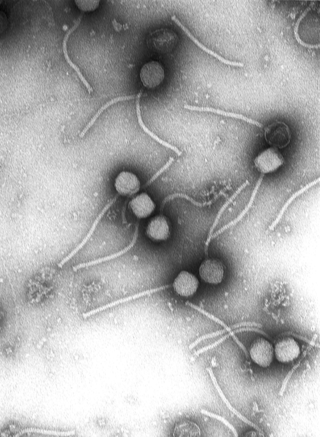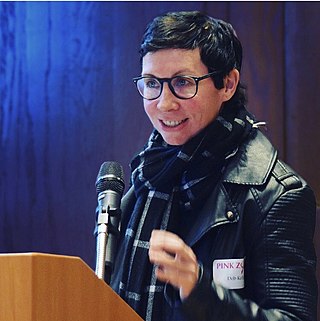Related Research Articles

Virology is the scientific study of biological viruses. It is a subfield of microbiology that focuses on their detection, structure, classification and evolution, their methods of infection and exploitation of host cells for reproduction, their interaction with host organism physiology and immunity, the diseases they cause, the techniques to isolate and culture them, and their use in research and therapy.

SV40 is an abbreviation for simian vacuolating virus 40 or simian virus 40, a polyomavirus that is found in both monkeys and humans. Like other polyomaviruses, SV40 is a DNA virus that sometimes causes tumors in animals, but most often persists as a latent infection. SV40 has been widely studied as a model eukaryotic virus, leading to many early discoveries in eukaryotic DNA replication and transcription.

Howard Martin Temin was an American geneticist and virologist. He discovered reverse transcriptase in the 1970s at the University of Wisconsin–Madison, for which he shared the 1975 Nobel Prize in Physiology or Medicine with Renato Dulbecco and David Baltimore.

An oncovirus or oncogenic virus is a virus that can cause cancer. This term originated from studies of acutely transforming retroviruses in the 1950–60s, when the term oncornaviruses was used to denote their RNA virus origin. With the letters RNA removed, it now refers to any virus with a DNA or RNA genome causing cancer and is synonymous with tumor virus or cancer virus. The vast majority of human and animal viruses do not cause cancer, probably because of longstanding co-evolution between the virus and its host. Oncoviruses have been important not only in epidemiology, but also in investigations of cell cycle control mechanisms such as the retinoblastoma protein.
An oncolytic virus is a virus that preferentially infects and kills cancer cells. As the infected cancer cells are destroyed by oncolysis, they release new infectious virus particles or virions to help destroy the remaining tumour. Oncolytic viruses are thought not only to cause direct destruction of the tumour cells, but also to stimulate host anti-tumour immune system responses. Oncolytic viruses also have the ability to affect the tumor micro-environment in multiple ways.

The Leibniz Institute of Virology was founded in 1948 by Heinrich Pette, a German neurologist. It began as a research facility to create a polio vaccine. It is now a private foundation and involved with basic research in virology and the immune responses of organisms. The institute is a non-profit public beneficiary organisation and an independent member of the Leibniz Association, located in Hamburg.
In the diagnostic laboratory, virus infections can be confirmed by a myriad of methods. Diagnostic virology has changed rapidly due to the advent of molecular techniques and increased clinical sensitivity of serological assays.

Harald zur Hausen NAS EASA APS was a German virologist. He carried out research on cervical cancer and discovered the role of papilloma viruses in cervical cancer, for which he received the Nobel Prize in Physiology or Medicine in 2008. He was chairman of the German Cancer Research Center in Heidelberg.
The University of Wisconsin Carbone Cancer Center (UWCCC) is a comprehensive cancer center in Wisconsin, as designated by the National Cancer Institute (NCI), the lead federal agency for cancer research. It is an integral part of both the University of Wisconsin (UW) and the University of Wisconsin Hospital and Clinics. It is located in Madison, Wisconsin.

Etienne de Harven (1928-2019) was a Belgian-born pathologist and electron microscopist. Born in Brussels, he did most of his work in New York City, Paris and Toronto. He did pioneering research on viruses, mostly related to murine leukemia. He is former President of the Electron Microscopy Society of America.
Peter K. Vogt is an American molecular biologist, virologist and geneticist. His research focuses on retroviruses and viral and cellular oncogenes.

June Dalziel Almeida was a Scottish virologist, a pioneer in virus imaging and identification. Her skills in electron microscopy earned her an international reputation.

Demetrios A. Spandidos is a Greek virologist and cancer researcher. He is an emeritus professor at the University of Crete where he was professor of virology from 1989 till 2015. He is also the founder of Spandidos Publications and the editor-in-chief of all eight of its journals.
Lutz Gissmann is a German virologist and was head of the division Genome Modifications and Carcinogenesis at the German Cancer Research Center (DKFZ) in Heidelberg until his retirement in 2015. Lutz Gissmann is known for his seminal research in the field of human papillomaviruses (HPV) and their causal association with human cancer, especially cervical cancer. In his early work, he demonstrated genetic heterogeneity among HPV isolates leading the way to the now well-established concept of distinct HPV types of which some are associated with specific benign or malignant disease. In the early 1980s in the laboratory of later Nobel Prize laureate Harald zur Hausen he was the first to isolate and characterize HPV16 and HPV18, the two most oncogenic HPV types causing the vast majority of HPV-induced anogenital and head-and-neck cancers. This groundbreaking work of Lutz Gissmann provided experimental evidence for the causal association of specific HPV types with human cancer, and laid the foundation for the development of prophylactic HPV vaccines for the prevention of cervical cancer and other HPV-induced cancers. His current research interest is on development of second generation prophylactic and therapeutic HPV vaccines.

Maurice Green was an American virologist. He was regarded as a pioneer in the study of animal viruses, in particular their role in cancer. Green founded the Institute of Molecular Virology at St. Louis University School of Medicine in the late 1950s, and later served as its chairman.
Batravirus ranidallo1, also known as Ranid herpesvirus 1 (RaHV-1), is a double-stranded DNA virus within the order Herpesvirales. The virus was initially observed within renal tumors in 1934 by Baldwin Lucké, and more recently has become identifiable through the use of PCR in samples isolated from frog tumors. RaHV-1 causes renal tumors within the northern leopard frog, Rana pipiens. The virus has not yet been isolated in vitro within cell lines, meaning that while its existence and symptoms are fairly evident, its methods of transmission, cell infection, and reproduction are largely unknown.
Gueh-Djen (Edith) Hsiung was a virologist and professor emeritus of laboratory medicine. She was one of the first women to achieve the rank of professor at the Yale School of Medicine.

Deborah F. Kelly is an American biomedical engineer who is a professor at Pennsylvania State University. Her research makes use of cryogenic electron microscopy to better understand human development and disease. She serves as President of the Microscopy Society of America.

Lev Aleksandrovich Zilber was a Soviet micro-biologist, virologist, and immunologist; academician of the USSR Academy of Medical Sciences, founder of the Soviet school of virology. The elder brother of the writer Veniamin Kaverin.
References
- 1 2 3 4 5 Yuriy Kovaliv (20 June 2014). "Леонтій Дмоховський". www.ukrainiansintheuk.info (in Ukrainian). Ukrainians in the United Kingdom. Retrieved 2022-03-06.
- ↑ Звідомлення Виділу «Кружка Родичів» при Державній Ґімназії з українською мовою навчання в Перемишлі за шкільний рік 1935—1936 — 2nd edition — Clifton, 1976. — p. 171.
- 1 2 Dr. Leon Dmochowski, Researcher in Virology Online archive of an article in The New York Times , September 28, 1981, Section B, Page 6
- ↑ Pundiy P. 'Dmokhovsky Lev (Leontiy-Lyudomyr)', in Encyclopedia of Modern Ukraine in 30 volumes / ed. count. : Im. Dziuba [etc.]; NAS of Ukraine, Shevchenko Scientific Society, Кyiv, 2008. - vol. 8: Дл- Дя. - 716 p. - ISBN 978-966-02-4458-0, accessdate: March 6, 2022
- ↑ Find a Grave Memorial: Leon L Dmochowski (1909-1981) - Find a Grave Memorial, accessdate: March 6, 2022
- Melnychuk B. 'Дмоховський Леонтій-Людомир', (in Ukrainian) Ternopil Encyclopedic Dictionary : in 4 v. / editorial board: H. Yavorskyi and other, Ternopil: "Zbruch", 2004, V. 1: А—Й, S. 504. — ISBN 966-528-197-6 .